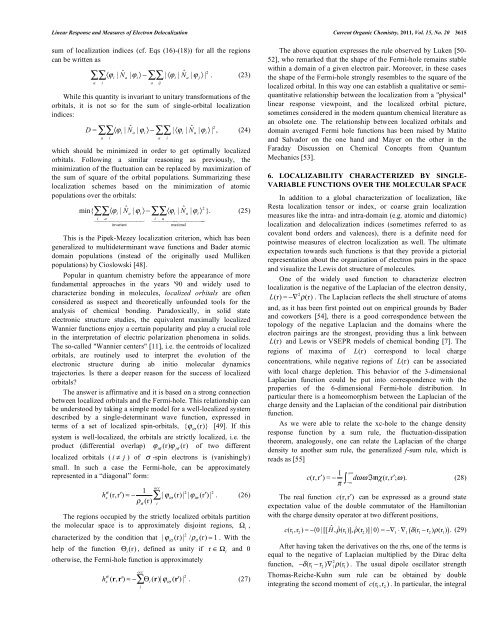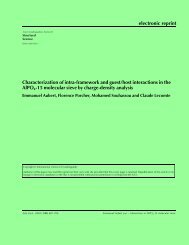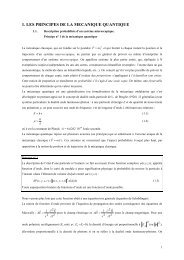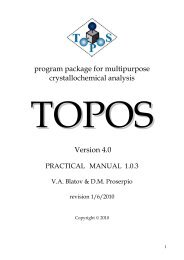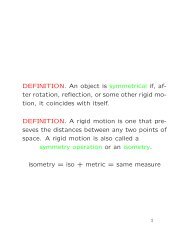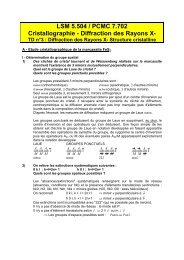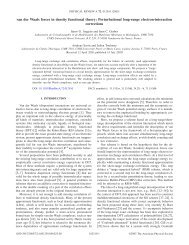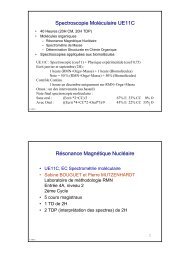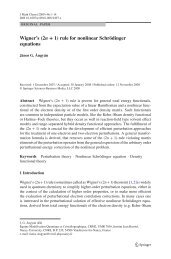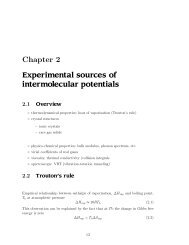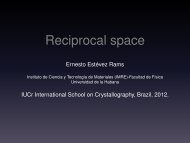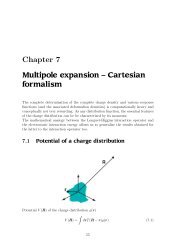Linear Response and Measures of Electron Delocalization ... - CRM2
Linear Response and Measures of Electron Delocalization ... - CRM2
Linear Response and Measures of Electron Delocalization ... - CRM2
Create successful ePaper yourself
Turn your PDF publications into a flip-book with our unique Google optimized e-Paper software.
<strong>Linear</strong> <strong>Response</strong> <strong>and</strong> <strong>Measures</strong> <strong>of</strong> <strong>Electron</strong> <strong>Delocalization</strong> Current Organic Chemistry, 2011, Vol. 15, No. 20 3615<br />
sum <strong>of</strong> localization indices (cf. Eqs (16)-(18)) for all the regions<br />
can be written as<br />
i<br />
| ˆNa | i<br />
| i<br />
| ˆNa | j<br />
| 2 . (23)<br />
a<br />
i<br />
a<br />
While this quantity is invariant to unitary transformations <strong>of</strong> the<br />
orbitals, it is not so for the sum <strong>of</strong> single-orbital localization<br />
indices:<br />
D = i<br />
| ˆNa | i<br />
| i<br />
| ˆNa | i<br />
| 2 , (24)<br />
a<br />
i<br />
which should be minimized in order to get optimally localized<br />
orbitals. Following a similar reasoning as previously, the<br />
minimization <strong>of</strong> the fluctuation can be replaced by maximization <strong>of</strong><br />
the sum <strong>of</strong> square <strong>of</strong> the orbital populations. Summarizing these<br />
localization schemes based on the minimization <strong>of</strong> atomic<br />
populations over the orbitals:<br />
min{<br />
<br />
i<br />
| ˆNa | i<br />
<br />
i<br />
a <br />
invariant<br />
<br />
ij<br />
a<br />
i<br />
i<br />
| ˆNa | i<br />
2 }. (25)<br />
i<br />
a <br />
maximal<br />
This is the Pipek-Mezey localization criterion, which has been<br />
generalized to multideterminant wave functions <strong>and</strong> Bader atomic<br />
domain populations (instead <strong>of</strong> the originally used Mulliken<br />
populations) by Cioslowski [48].<br />
Popular in quantum chemistry before the appearance <strong>of</strong> more<br />
fundamental approaches in the years '90 <strong>and</strong> widely used to<br />
characterize bonding in molecules, localized orbitals are <strong>of</strong>ten<br />
considered as suspect <strong>and</strong> theoretically unfounded tools for the<br />
analysis <strong>of</strong> chemical bonding. Paradoxically, in solid state<br />
electronic structure studies, the equivalent maximally localized<br />
Wannier functions enjoy a certain popularity <strong>and</strong> play a crucial role<br />
in the interpretation <strong>of</strong> electric polarization phenomena in solids.<br />
The so-called "Wannier centers" [11], i.e. the centroids <strong>of</strong> localized<br />
orbitals, are routinely used to interpret the evolution <strong>of</strong> the<br />
electronic structure during ab initio molecular dynamics<br />
trajectories. Is there a deeper reason for the success <strong>of</strong> localized<br />
orbitals<br />
The answer is affirmative <strong>and</strong> it is based on a strong connection<br />
between localized orbitals <strong>and</strong> the Fermi-hole. This relationship can<br />
be understood by taking a simple model for a well-localized system<br />
described by a single-determinant wave function, expressed in<br />
terms <strong>of</strong> a set <strong>of</strong> localized spin-orbitals, { i<br />
(r)} [49]. If this<br />
system is well-localized, the orbitals are strictly localized, i.e. the<br />
product (differential overlap) i<br />
(r) j<br />
(r) <strong>of</strong> two different<br />
localized orbitals ( i j ) <strong>of</strong> -spin electrons is (vanishingly)<br />
small. In such a case the Fermi-hole, can be approximately<br />
represented in a “diagonal” form:<br />
h x<br />
(r, r ) 1<br />
occ<br />
| i<br />
(r)| 2 | i<br />
( r )| 2 . (26)<br />
<br />
(r) i<br />
The regions occupied by the strictly localized orbitals partition<br />
the molecular space is to approximately disjoint regions, i<br />
,<br />
characterized by the condition that | i<br />
(r)| 2 / <br />
(r) 1 . With the<br />
help <strong>of</strong> the function i<br />
(r) , defined as unity if r i<br />
<strong>and</strong> 0<br />
otherwise, the Fermi-hole function is approximately<br />
occ<br />
h x<br />
(r,r') i<br />
(r)| i<br />
(r') | 2 . (27)<br />
i<br />
The above equation expresses the rule observed by Luken [50-<br />
52], who remarked that the shape <strong>of</strong> the Fermi-hole remains stable<br />
within a domain <strong>of</strong> a given electron pair. Moreover, in these cases<br />
the shape <strong>of</strong> the Fermi-hole strongly resembles to the square <strong>of</strong> the<br />
localized orbital. In this way one can establish a qualitative or semiquantitative<br />
relationship between the localization from a "physical"<br />
linear response viewpoint, <strong>and</strong> the localized orbital picture,<br />
sometimes considered in the modern quantum chemical literature as<br />
an obsolete one. The relationship between localized orbitals <strong>and</strong><br />
domain averaged Fermi hole functions has been raised by Matito<br />
<strong>and</strong> Salvador on the one h<strong>and</strong> <strong>and</strong> Mayer on the other in the<br />
Faraday Discussion on Chemical Concepts from Quantum<br />
Mechanics [53].<br />
6. LOCALIZABILITY CHARACTERIZED BY SINGLE-<br />
VARIABLE FUNCTIONS OVER THE MOLECULAR SPACE<br />
In addition to a global characterization <strong>of</strong> localization, like<br />
Resta localization tensor or index, or coarse grain localization<br />
measures like the intra- <strong>and</strong> intra-domain (e.g. atomic <strong>and</strong> diatomic)<br />
localization <strong>and</strong> delocalization indices (sometimes referred to as<br />
covalent bond orders <strong>and</strong> valences), there is a definite need for<br />
pointwise measures <strong>of</strong> electron localization as well. The ultimate<br />
expectation towards such functions is that they provide a pictorial<br />
representation about the organization <strong>of</strong> electron pairs in the space<br />
<strong>and</strong> visualize the Lewis dot structure <strong>of</strong> molecules.<br />
One <strong>of</strong> the widely used function to characterize electron<br />
localization is the negative <strong>of</strong> the Laplacian <strong>of</strong> the electron density,<br />
L(r)= 2 (r) . The Laplacian reflects the shell structure <strong>of</strong> atoms<br />
<strong>and</strong>, as it has been first pointed out on empirical grounds by Bader<br />
<strong>and</strong> coworkers [54], there is a good correspondence between the<br />
topology <strong>of</strong> the negative Laplacian <strong>and</strong> the domains where the<br />
electron pairings are the strongest, providing thus a link between<br />
L(r) <strong>and</strong> Lewis or VSEPR models <strong>of</strong> chemical bonding [7]. The<br />
regions <strong>of</strong> maxima <strong>of</strong> L(r) correspond to local charge<br />
concentrations, while negative regions <strong>of</strong> L(r) can be associated<br />
with local charge depletion. This behavior <strong>of</strong> the 3-dimensional<br />
Laplacian function could be put into correspondence with the<br />
properties <strong>of</strong> the 6-dimensional Fermi-hole distribution. In<br />
particular there is a homeomorphism between the Laplacian <strong>of</strong> the<br />
charge density <strong>and</strong> the Laplacian <strong>of</strong> the conditional pair distribution<br />
function.<br />
As we were able to relate the xc-hole to the change density<br />
response function by a sum rule, the fluctuation-dissipation<br />
theorem, analogously, one can relate the Laplacian <strong>of</strong> the charge<br />
density to another sum rule, the generalized f-sum rule, which is<br />
reads as [55]<br />
+<br />
c(r, r )= 1 <br />
dm(r, r ;). (28)<br />
<br />
The real function c(r, r ) can be expressed as a ground state<br />
expectation value <strong>of</strong> the double commutator <strong>of</strong> the Hamiltonian<br />
with the charge density operator at two different positions,<br />
c(r 1<br />
,r )=0|[[Ĥ, ˆ(r 2 1)], ˆ(r 2<br />
)] | 0 = 1<br />
1 ( (r 1<br />
r 2<br />
)(r 1<br />
)). (29)<br />
After having taken the derivatives on the rhs, one <strong>of</strong> the terms is<br />
equal to the negative <strong>of</strong> Laplacian multiplied by the Dirac delta<br />
function, (r 1<br />
r 2<br />
) 2 1<br />
(r 1<br />
) . The usual dipole oscillator strength<br />
Thomas-Reiche-Kuhn sum rule can be obtained by double<br />
integrating the second moment <strong>of</strong> c(r 1<br />
,r 2<br />
) . In particular, the integral


